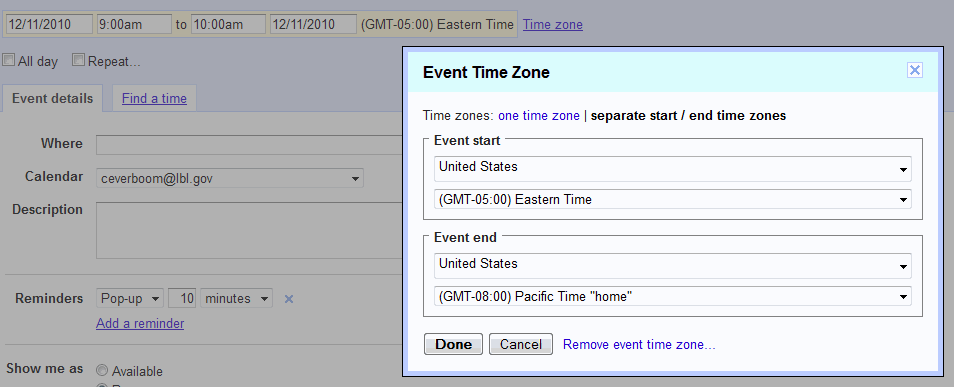It's been over three years since IT began a program to aggressively evaluate cloud services and ensure that every new service we consider includes an evaluation of available cloud offerings. We believe that cloud services have the potential to offer better, more frequently updated features and additional security while potentially reducing our overall costs and environmental footprint. That doesn't mean that every service is best delivered from the cloud, but we want to make sure we're evaluating these services appropriately and making them part of our service mix where they fit in best.
Our largest cloud service rollout to date has been Google Apps. Google Docs and Sites was rolled out over 18 months ago, Calendar migration was completed in the fall and, as of November, the migration of mail from our IMAP system is essentially complete. We're looking forward to additional Google Apps core services development in the coming year, including the transition to GA+ which will provide Berkeley Lab users with the ability to use their LBL credentials across a range of work-related Google Apps including Google Code, Reader, and Picassa.
One cool feature of Google Apps is the Marketplace, which allows IT to add additional capabilities to the Google Apps Suite through third party providers in just a few clicks. Smartsheet and Manymoon, two great applications with different takes on project management in the cloud, have been great additions to our collaborative services suite that offer point solutions to particular collaboration problems.
On the business systems side, we've completed the rollout of two Software as a Servie Applications (SaaS), Point and Ship (for managing shipping) and Daptiv (for Ops project management). Taleo, a SaaS Talent Management Application, is being deployed now and will be our first major business system in the cloud.
On the evaluation front, we're looking at SaaS applications in the service desk management and HR space as part of larger evaluations of our strategic direction in these areas.
All of these systems do or will leverage IT's Identity Management Infrastructure (SAML/Shib) which allows our users to continue to use one password and one account even in the cloud.
In the new year, we'll also be launching the SaaS service Carbonite for user-managed desktop backups, which will radically reduce the cost of desktop/laptop backups to the Laboratory.
Finally, we continue to work with Amazon's various offerings to make these services available to the Lab Community. Amazon S3 continues to be evaluated for backups of large datasets. Amazon EC2 servers are available to anyone at the Lab, with LBL-specific templates and a VPN connection to LBLnet. After beta testing, we are preparing to test the first scientific application on Amazon HPC instances over the next few weeks. We want to enable the Laboratory community to make easy use of these and other cloud platforms in the future, so we're working to negotiate agreements and put in place systems which allow us to provide "on demand" services to the community without the need to go through complex procurements for each new use of these services.
Our colleagues at NERSC have been testing Amazon's new HPC instances, and we're looking forward to making both regular EC2 and EC2 HPC instances available to the Lab with the expertise to configure and manage them in the coming months.
Overall, we believe our cloud strategy has been working well. We're on a path that will allow more and more of our resources to be devoted to the services that enable the scientific mission of the Laboratory and improve our operational efficiency.
Is your Division or Group making use of cloud services? Tell us about it by sending email to collaborate at lbl.gov.
A much requested feature has been implemented by Google. It is now possible to create an event and select a timezone for the meeting (the start and end times can each specify a different timezone). This is how it looks when you click on the timezone link.
We often think of Cloud Services like Google Apps as keeping the strain off your desktop or laptop, but many of these services actually require quite a bit of horsepower from your browser. Google Chrome was built by Google to have excellent javascript performance which allows Gmail and other Google Apps to run more smoothly. Google Chrome will be considered for inclusion as part of our standard software package for ops desktops and we encourage the Laboratory to try it out to see whether it works well for you. And whatever browser you use, remember that it's more important then ever (for both security and usability) to keep your browser completely up to date.
Why use the Google Chrome Browser ?
These reasons were provided by James Lee of our Google Team:
- A single input field, the "omnibox" (Firefox could do this too, with some configuration changes. It's far simpler than having both an address bar and a search bar)
- Syncing of Bookmarks, Preferences, Extensions, Themes, etc.
- Better insulation from problems; in many cases, only a single tab will crash, vs. the entire browser.
- Better RAM utilization (in my anecdotal, totally non-scientific experience)
- Extensions can be installed without restarting the browser (maybe Firefox can do this too now?)
- PDF viewer & sandbox
- Many nice Google-created extensions, such as
- Send from Gmail, that makes it easy to set Gmail (even lbl.gov Gmail) as the default mailto: handler
- Google Calendar
- Docs & PDF/Powerpoint Viewer
- Web clipboard
- Screen capture (This may replace Skitch for me. It will be especially cool if/when they enable saving to Gdocs)
- There's even an interactive "New to Google Chrome" guide .
